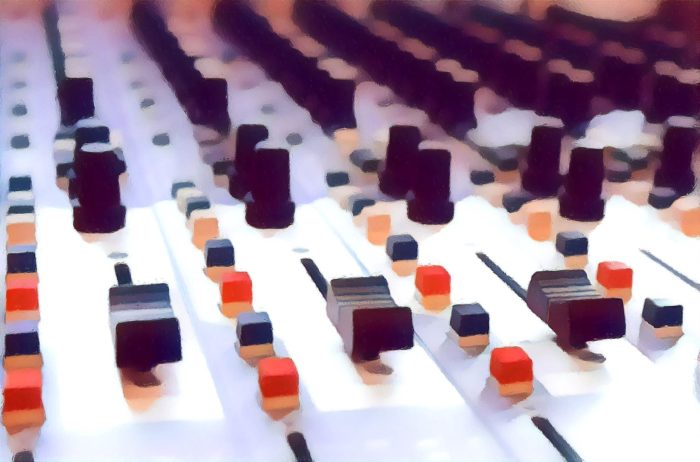Analog gear does look cool, though.
Please Remember:
The opinions expressed are mine only. These opinions do not necessarily reflect anybody else’s opinions. I do not own, operate, manage, or represent any band, venue, or company that I talk about, unless explicitly noted.

 Want to use this image for something else? Great! Click it for the link to a high-res or resolution-independent version.
Want to use this image for something else? Great! Click it for the link to a high-res or resolution-independent version.Although the fight isn’t nearly so pitched as it once was, some folks might still ask: “Is analog better than digital?”
Analog audio gear does indeed have one major advantage over its number-crunching counterparts. Especially with the right lighting, it often looks a lot cooler on Instagram. Other than that, I’ll take digital over analog any day of the week, and twice on Sunday.
Everyone’s got their own opinion, of course, and I can respect that. I believe that I can back mine up pretty convincingly.
“Back in the day,” you could make a case that analog sounded better. I maintain that this was because both analog and digital grunged up signals to about the same degree, but that digital grunge is generally perceived as being less pleasing. We’re in the 21st Century now, though, and those problems were fixed a good while back. Today’s digital is clear, hyper-accurate, and pristine, even with all manner of gain-changes piled on and low-level signals being passed. Along with that, digital gear is compact, lightweight, flexible, cheap, and feature rich.
Analog, on the other hand, is large, heavy, inflexible, expensive, and feature-limited. It also does not sound “better.”
What do I mean?
Let’s take the example of a modern, digital console, like an X32 Core. Such a console is the ultimate expression of digital’s strengths:
First of all, the setup is tiny. With six rack-spaces handy, you can have 32 X 16 I/O, plus a separate console for FOH and monitor world. Of course, the system has no control surface, so you’ll need a laptop or tablet to act as a “steering wheel.” Even so, the whole shebang could fit in the trunk of a small car. A similar analog setup would necessitate a good-sized SUV, truck, or van for transport.
This also factors into the lightweight aspect. I don’t know exactly how much the above system weighs, but I know it’s a LOT less than two, 32 input analog boards. Even with no other accoutrements, the old-school solution will put you into the 80-pound range at a minimum. Add in a traditional multicore and stagebox splitters, and…well…it’s a lot to carry.
The flexibility argument comes next. Although everything has a design limit, gear that runs on code can have updates applied easily. As long as any new functionality falls within what the hardware and basic software platform can manage, that new functionality can be added – through a simple software update – for as long as the manufacturer cares to work on the system. Front-end control is just as malleable, if not more. If it turns out that the software portion of the interface could do things better, an update gets written and that’s that. Equipment that operates on physical circuits either has no path for similar changes, or if it does, accomplishing the changes is a task that’s profoundly difficult in comparison.
Cost and feature-set dovetail into one another. At the very bare minimum, you can purchase the mixers for a dual-console analog system for about $2800. That’s not too bad in the grand scheme of things, until you realize that a similar investment in the digital world can also get you the stagebox and snake. Also, the digital system will have tons of processing muscle that the analog setup won’t be able to touch. Twelve monitor mixes, fully-configurable channel-per-channel dynamics, four-band parametric EQ, a sweepable filter, EQ and dynamics on every output, plus eight additional processing units? Good luck finding that in an integrated analog package. Such a thing doesn’t even exist as far as I know, and anything even remotely comparable won’t be found for less than tens of thousands of dollars.
So, what about my last point? That analog doesn’t actually sound better?
It doesn’t. No, really. It may sound different. You may like that it sounds different. I can’t argue with personal taste. The reality, though, is that the different sound (especially “warmth” or “fatness” or “depth”) is the product of the gear not passing a clean signal. Maybe the circuitry imparts a nice, low-frequency bump somewhere. Maybe it rolls off in the highs. Maybe there’s just a touch of even-harmonic distortion that creeps in at your preferred gain structure. That’s nifty, but in any objective sense it’s either a circuit that’s inflexibly pre-equalized or is forgiving when being run hard. That may be what some people want, but it’s not what I want, and I’m not going to label it as “better” when a pleasing result is precipitated by a design limitation. (Or only appears when the gain is set just-so.)
Analog isn’t dead, and it isn’t going to die. Our digital systems require well-designed analog stages on the input and output sides to function in real life. At the same time, there are good reasons to make as much of the signal chain digital as is possible. Digital sounds great, and holds too many practical advantages for it to lose out in an objective comparison.